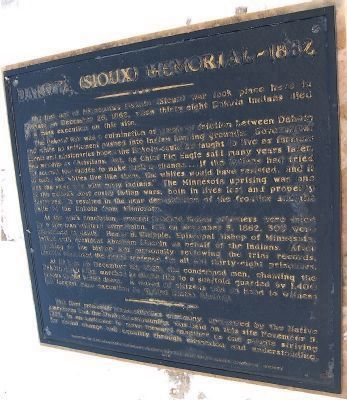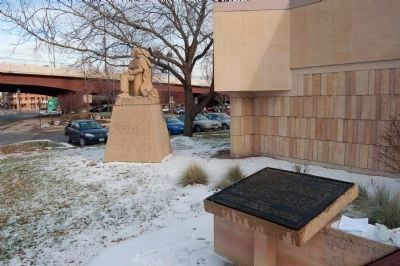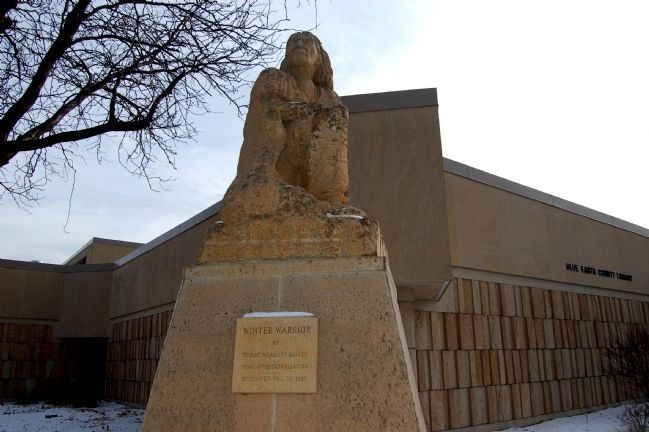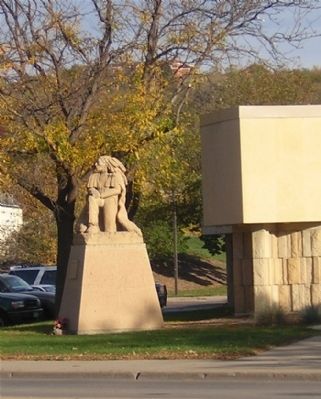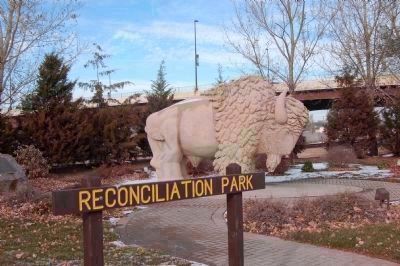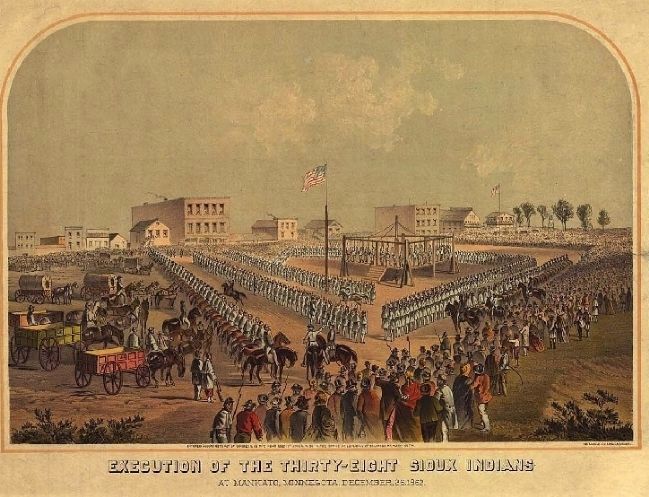Mankato in Blue Earth County, Minnesota — The American Midwest (Upper Plains)
Dakota (Sioux) Memorial – 1862
The Dakota War was a culmination of years of friction between Dakota and whites as settlement pushed into Indian hunting grounds. Government agents and missionaries hoped the Dakota could be taught to live as farmers and worship as Christians but Chief Big Eagle said many years later, “It seemed too sudden to make a change . . . If the Indians had tried to make the whites live like them, the whites would have resisted and it was the same with many Indians.” The Minnesota uprising was one of the nation’s most costly Indian wars, both in lives lost and property destroyed. It resulted in the near depletion of the frontier and the exile of the Dakota from Minnesota.
At the war’s conclusion several hundred Indians were tried by a five man territory commission and on November 5, 1862, 303 were sentenced to death. Henry B. Whipple, Episcopal Bishop of Minnesota met with President Abraham Lincoln on behalf of the Indians. After listening to the bishop and personally reviewing the trial records, Lincoln commuted the death sentence for all but thirty-eight prisoners.
At 10 am on December 26, 1862, the condemned men, chanting the Dakota death song, marched in single file to a scaffold guarded buy 1,400 troops in full battle dress. A crowd of citizens were on hand to witness the largest mass execution in United States history.
Erected 1978 by the Minnesota Historical Society and the Blue Earth County Historical Society.
Topics and series. This historical marker is listed in this topic list: Native Americans. In addition, it is included in the Minnesota Historical Society series list. A significant historical month for this entry is November 1898.
Location. 44° 10.078′ N, 94° 0.155′ W. Marker is in Mankato, Minnesota, in Blue Earth County. Marker is at the intersection of East Main Street and North Riverfront Drive on East Main Street. It is at the Blue Earth County Public Library. Touch for map. Marker is at or near this postal address: 100 E Main St, Mankato MN 56001, United States of America. Touch for directions.
Other nearby markers. At least 8 other markers are within walking distance of this marker
. Korean War (within shouting distance of this marker); Minnesota River Steamboating (about 300 feet away, measured in a direct line); Navigating the River (approx. 0.2 miles away); Early Settlers (approx. 0.2 miles away); Early European Explorers (approx. 0.2 miles away); Native Americans (approx. 0.2 miles away); Sinclair Lewis House (approx. 0.3 miles away); Washington Park / Fourth Street Route Depot Grounds (approx. 0.3 miles away). Touch for a list and map of all markers in Mankato.
Regarding Dakota (Sioux) Memorial – 1862. “The Winter Warrior,” sculpted out of a native Kasota Limestone found in the Mankato area by Tomas Miller, was created as a gift from the Mankato community to the Minnesota Dakota during 1987, the “Year of Reconciliation.” This gift was one of many efforts to begin a process of healing the wounds among the Minnesota Dakota and non-Indian people. It was unveiled on December 26, 1987, the 125th Anniversary of execution of 38 Dakota warriors, the largest mass execution in United States history. This statue is located on the execution site next to the Mankato Public Library across the street from Reconciliation Park.
Additional commentary.
1. Amos Owen’s 1987 Prayer of Reconciliation
(A plaque on a boulder in Mankato’s Reconciliation Park, across the street from this marker, honors the significant efforts of the Dakota towards reconciliation among all people. It reads as follows.) In honor of Amos Owen, Norman Crooks and Hereditary Chief Ernest Wabasha for their lasting efforts towards reconciliation among all people.
Grandfather, I come to you this day in my humble way to offer my prayers for the thirty-eight Dakota who perished in Mankato in the year of 1862.
To the West, I pray to the Horse Nation, and to the North, I pray to the Elk People.
To the East, I pray to the Buffalo Nation, and to the South, the Spirit People.
To the Heavens, I pray to the Great Spirit and to the Spotted Eagle.
And Below, I pray to Mother Earth to help us in this time of reconciliation.
Grandfather, I offer these prayers in my humble way.
To all my relations.
—Amos Owen
Reconciliation Park Founders: Hereditary Chief Ernest Vernell Wabasha • Mankato Mayor Stanley Christ • Louis G. “Bud” Lawrence, Co-chairman • James H. Buckley, Sr., Co-chairman • Jim Petersen • Bruce and Sheryl Dowlin • Perry Wood • Jeffrey Kagermeier, A.I.A. • Tomas M. Miller, Sculptor. (dedicated) September 21, 1997.
— Submitted December 7, 2008.
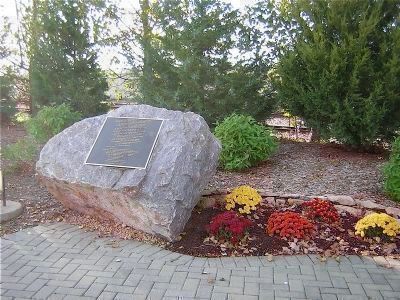
Photographed By Sheryl Dowlin, October 9, 2006
6. Amos Owen Prayer Plaque
The Reconciliation Park plaque includes the “Prayer of
Reconciliation” that the late Mr. Amos Owen (Dakota)—a spiritual leader to many—offered during the 1987 Minnesota Year of Reconciliation efforts between the Minnesota Dakota and non-Indian communities.
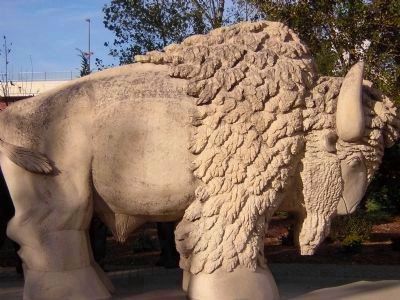
Photographed By Sheryl Dowlin, October 9, 2006
7. Buffalo at Reconciliation Park
Tomas Miller sculpted the buffalo from a 67-ton block of local Kasota
limestone; it is surrounded by native flowers and prairie grasses. The
buffalo symbolizes the spiritual survival of the Dakota People and
honors the Dakota heritage of this area. The park is a place to reflect,
meditate and remember.
Credits. This page was last revised on July 19, 2020. It was originally submitted on December 7, 2008, by Sheryl and Bruce Dowlin of Boise, Idaho. This page has been viewed 13,591 times since then and 288 times this year. Photos: 1, 2, 3, 4, 5, 6, 7. submitted on December 7, 2008, by Sheryl and Bruce Dowlin of Boise, Idaho. 8. submitted on December 10, 2008, by J. J. Prats of Powell, Ohio. • J. J. Prats was the editor who published this page.
